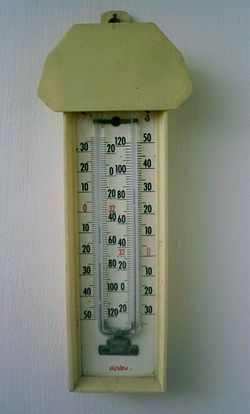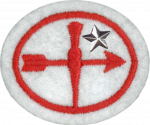Difference between revisions of "AY Honors/Weather - Advanced/Answer Key/es"
(Created page with "{{clear}}") |
(Created page with "</noinclude> <!-- 3. ¿Cuáles son los frentes fríos y frentes cálidos? ¿Cómo se mueven y que condiciones meterológicas producen? -->") |
||
| Line 34: | Line 34: | ||
{{ansreq|page={{#titleparts:{{PAGENAME}}|2|1}}|num=3}} | {{ansreq|page={{#titleparts:{{PAGENAME}}|2|1}}|num=3}} | ||
<noinclude></noinclude> | <noinclude></noinclude> | ||
| − | <!-- 3. | + | <!-- 3. ¿Cuáles son los frentes fríos y frentes cálidos? ¿Cómo se mueven y que condiciones meterológicas producen? --> |
| − | |||
| − | |||
| − | |||
{{clear}} | {{clear}} | ||
Revision as of 14:08, 1 March 2021
| Climatología - Avanzado | ||
|---|---|---|
| Asociación General
|
Destreza: 2 Año de introducción: 1949 |
|
Requisitos
1
Para consejos e instrucciones, véase Climatología.
2
3
4
4a
4b
4c
4d
4e
4f
4g
4h
4i
5
Registering Thermometer

6
7
The amount of water that air can hold depends on the temperature. The hotter it gets, the more water the air can hold. At any given temperature, the air can become so saturated with water that it cannot hold any more. Water will not evaporate under this condition.
8
The Earth's atmosphere consists, from the top down, of the exosphere, thermosphere, mesosphere, stratosphere, and the troposphere.
9
This requirement is very similar to one found in the Explorer IA curriculum, except that Explorers are required to keep these records for two weeks and take readings twice a day. You can also combine these requirements with those in the Weather honor. If you forget to take records for a day, do not despair. As long as you have 21 readings, you can count this as three weeks.
9a
9b
9c
9d
Unless you have a registering thermometer or a digital thermometer that records the daily extremes, this will have to come from official records.
9e
9f
10
Man has a greater impact on the climate than on the weather. The weather is the day-to-day conditions, while the climate covers long term averages. Man's production of greenhouse gases (such as carbon dioxide) has had and is having an effect on the global climate. These changes affect rainfall (increases in some areas, decreases in others) and the severity of storms.
Referencias
- Categoría: Tiene imagen de insignia
- Adventist Youth Honors Answer Book/Honors/es
- Adventist Youth Honors Answer Book/es
- Adventist Youth Honors Answer Book/Skill Level 2/es
- Categoría: Libro de respuestas de especialidades JA/Especialidades introducidas en 1949
- Adventist Youth Honors Answer Book/General Conference/es
- Adventist Youth Honors Answer Book/Nature/es
- Adventist Youth Honors Answer Book/Nature/Primary/es
- Adventist Youth Honors Answer Book/Stage 0/es
- AY Honors/Prerequisite/Weather/es
- AY Honors/See Also/Weather/es


